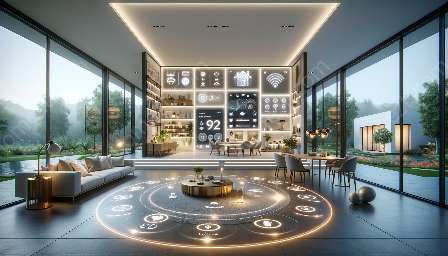Augmented reality (AR) has emerged as a revolutionary tool in the field of interior design, offering innovative solutions that transform the way designers create and visualize living spaces. This advanced technology not only enhances the design process but also integrates seamlessly with technological advances in interior design and intelligent home design, leading to the creation of immersive and interactive spaces that cater to the modern homeowners’ needs.
Understanding Augmented Reality
Augmented reality, often abbreviated as AR, is a cutting-edge technology that overlays digital information and virtual elements onto the real world, thereby augmenting the user’s perception of their environment. This technology can be harnessed through various devices, such as smartphones, tablets, and specialized AR glasses, providing an interactive and immersive experience.
Practical Applications of AR in Interior Design
1. Visualizing Designs
One of the key applications of AR in interior design is its ability to visualize designs in a real-world context. Designers can superimpose digital renderings of furniture, decor, and architectural elements onto the physical space, allowing clients to experience a realistic representation of the proposed design before implementation.
2. Space Planning and Layout
AR facilitates efficient space planning and layout design by enabling designers to virtually rearrange furniture and spatial configurations within a room. This capability allows for better utilization of space and assists in creating dynamic and functional interiors.
3. Interactive Product Catalogs
With AR, designers can create interactive product catalogs that enable clients to visualize and customize various design elements, such as flooring, wall finishes, and lighting fixtures, in real time. This level of interactivity enhances the decision-making process and fosters greater client engagement.
Compatibility with Technological Advances in Interior Design
The application of AR aligns seamlessly with the technological advances in interior design, complementing and enhancing the capabilities of design software and visualization tools. By integrating AR into design processes, designers can leverage advanced 3D modeling, rendering, and simulation technologies to create highly accurate and detailed virtual representations of interiors, leading to improved design precision and client communication.
Intelligent Home Design and AR Integration
Intelligent home design, characterized by the integration of smart devices and automation systems, can significantly benefit from the incorporation of AR technology. By utilizing AR, homeowners can visualize and interact with smart home features, such as connected appliances, lighting controls, and environmental sensors, within the context of their living spaces. This integration fosters a seamless blend of aesthetics and functionality, empowering homeowners to make informed decisions about the integration of intelligent systems into their homes.
The Future of AR in Interior Design
As AR technology continues to evolve, its impact on interior design is poised to expand further. The development of more sophisticated AR platforms, coupled with advancements in augmented reality hardware and software, will offer designers unprecedented capabilities to create immersive and personalized experiences for clients. Additionally, as augmented reality becomes more accessible and user-friendly, it is expected to become an integral part of the interior design workflow, revolutionizing the way spaces are conceptualized, designed, and experienced.
In conclusion, the application of augmented reality in interior design represents a groundbreaking shift in the industry, enabling designers to deliver captivating and functional living spaces. This innovative technology, coupled with its compatibility with technological advances in interior design and intelligent home design, is set to redefine the way designers, clients, and homeowners engage with the design process and interact with their living environments.


